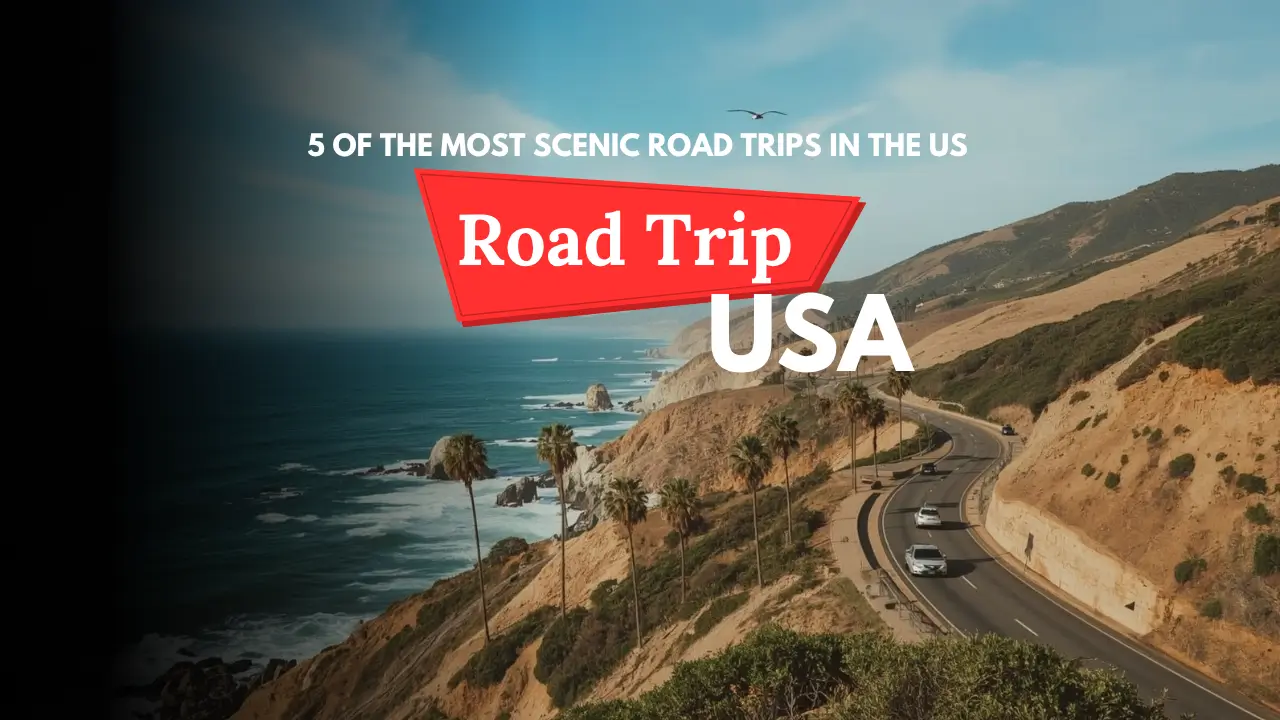What better way to explore the beauty of America than hitting the open road? 5 Of The Most Scenic Road Trips In The US will take you through breathtaking coastlines, rugged mountains, and iconic landscapes. Ready to discover routes that turn travel into a visual masterpiece?
From California’s Pacific Coast Highway to the Blue Ridge Parkway in the East, we’ve handpicked five road trips that deliver unforgettable views and photo-worthy stops. Route 66, Going-to-the-Sun Road, and the Overseas Highway also make the list. Each of these scenic routes promises a unique travel experience packed with nature, culture, and charm.
But this list doesn’t just come from personal picks—it’s shaped by recommendations from experts like National Geographic Traveler and road trip communities. Curious which route is the most dramatic or most peaceful? Let’s shift gears and dive into America’s five most scenic road trips!
5 Of The Most Scenic Road Trips In The US
1. Pacific Coast Highway (California)
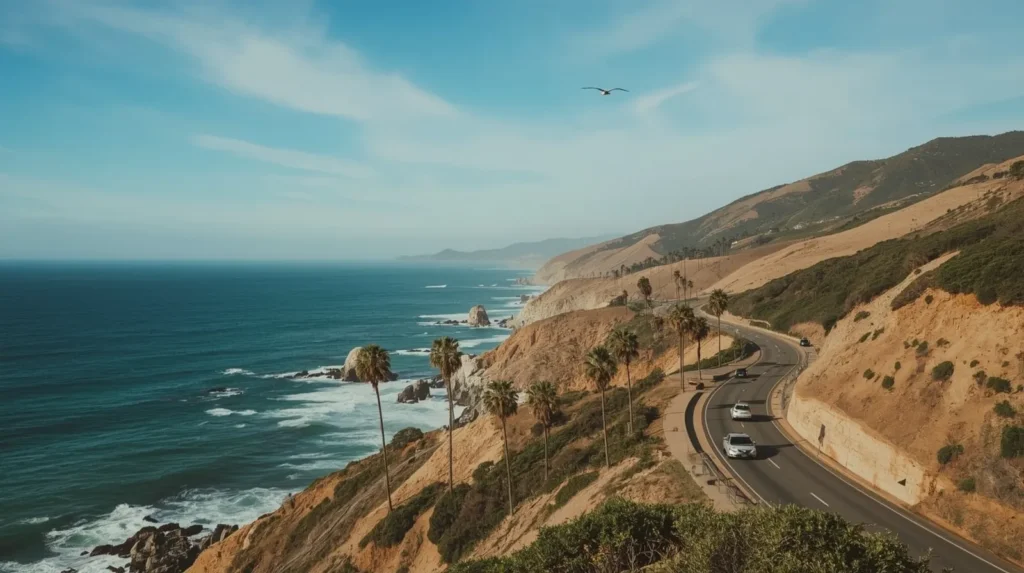
Image Credit: Leonardo
Overview and Highlights
The Pacific Coast Highway, or California State Route 1, is a jaw-dropping coastal journey that stretches over 600 miles from Dana Point in Southern California to Leggett in the north. It’s not just a road—it’s a ribbon of adventure that hugs the cliffs, offering some of the most breathtaking ocean views on Earth. If you’ve ever seen a car commercial with winding turns above a sparkling ocean, odds are it was filmed here.
What makes the PCH truly remarkable is its variety. You cruise through beach towns like Malibu, charming cities like Santa Barbara, lush vineyards near San Luis Obispo, and dramatic coastal vistas around Big Sur. And let’s not forget about the redwood forests, the golden beaches, and cliffs plunging into the Pacific Ocean—it’s sensory overload in the best way.
Driving the PCH is more than a road trip; it’s a cinematic experience where every twist and turn feels like the next scene in a blockbuster. Whether you’re a nature enthusiast, photographer, or just a traveler in search of soul-refreshing beauty, this route delivers it all.
Must-See Stops
- Big Sur: Known for its rugged cliffs, Bixby Creek Bridge, and Julia Pfeiffer Burns State Park. This is the crown jewel of the PCH.
- Monterey & Carmel-by-the-Sea: Ideal for artsy vibes, fine dining, and the famous 17-Mile Drive.
- Santa Barbara: A classy seaside city filled with Spanish architecture and palm-lined boulevards.
- Hearst Castle: This hilltop mansion offers a taste of opulence with sweeping views.
- Malibu: Perfect for beach breaks and celebrity spotting.
To truly enjoy these stops, plan a minimum of 5-7 days. Trust me, you’ll want to linger.
Best Time to Travel
While you can drive the PCH year-round, the sweet spot is late spring through early fall. From May to October, you’ll get clear skies, less fog, and ideal conditions to pull over and explore. Avoid the winter months if possible; landslides are common in Big Sur and fog can dampen those views.
2. Blue Ridge Parkway (Virginia to North Carolina)
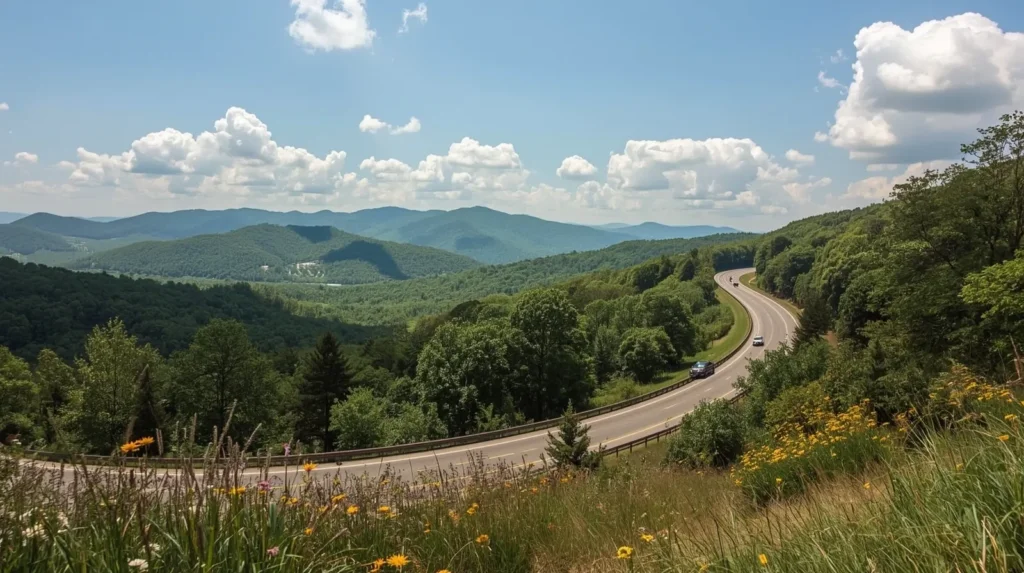
Image Credit: Leonardo
Overview and Highlights
If the Pacific Coast Highway is the ultimate ocean drive, the Blue Ridge Parkway is the king of mountain road trips. Spanning 469 miles from Virginia’s Shenandoah National Park down to North Carolina’s Great Smoky Mountains, this scenic byway has been nicknamed “America’s Favorite Drive”—and for good reason.
This isn’t a trip you rush through. It’s slow travel at its finest. There are no billboards, no traffic lights—just miles and miles of scenic pull-offs, dense forests, vibrant wildflowers, and panoramic mountain views. It’s a meditative drive, the kind where you roll the windows down and let the cool mountain air wash over you.
And fall? Oh boy, fall is magical here. With leaves igniting in every shade of orange, red, and gold, it’s like Mother Nature decided to show off. The speed limit is low for a reason: every bend reveals a new view that’ll make you hit the brakes in awe.
Top Attractions Along the Way
- Mabry Mill (Milepost 176): One of the most photographed spots on the Parkway, it’s straight out of a postcard.
- Peaks of Otter: Great for hiking, picnicking, and soaking in views of the rolling hills.
- Linville Falls: A multi-tiered waterfall that’s worth every step of the hike.
- Craggy Gardens: Visit in June for a stunning display of rhododendron blooms.
- Mount Mitchell: The highest peak east of the Mississippi River.
The Parkway is dotted with visitors centers, picnic spots, hiking trails, and overlooks, making it perfect for both short and extended getaways.
Ideal Season for the Drive
Fall (late September to early November) is unbeatable thanks to the legendary foliage. However, spring is also fantastic—especially April to June—when wildflowers bloom and everything turns a lush green. Avoid winter unless you’re prepared for road closures and icy conditions.
3. Route 66 (Illinois to California)
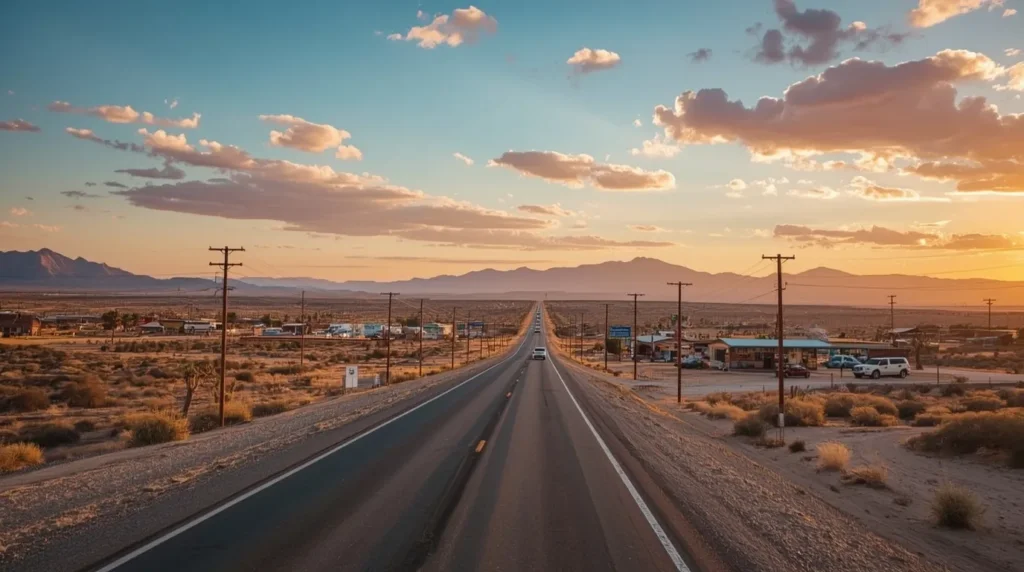
Image Credit: Leonardo
History and Cultural Significance
Route 66 isn’t just a road—it’s a legend. Dubbed the “Mother Road”, this 2,448-mile stretch once served as the main artery for those migrating west during the Dust Bowl and later became an icon of American freedom and car culture. Running from Chicago, Illinois to Santa Monica, California, it’s a living time capsule of 20th-century Americana.
Though parts of Route 66 have been decommissioned as an official highway, its spirit is alive and kicking. Motels with neon signs, retro diners, roadside attractions, vintage cars, and quirky small towns—it’s all still there, waiting for modern-day adventurers to discover it anew.
Traveling this route feels like flipping through a sepia-toned album filled with vintage charm, old-school vibes, and the heartbeat of a bygone era. It’s a pilgrimage for road trippers who want more than just scenery—they want stories.
Famous Stops and Experiences
- Chicago, IL: Start your journey with deep-dish pizza and a skyline river cruise.
- Cadillac Ranch (Amarillo, TX): A surreal art installation where you’re encouraged to spray-paint classic Cadillacs half-buried in the ground.
- Petrified Forest National Park (AZ): A prehistoric landscape with fossilized wood and desert vistas.
- Wigwam Motel (Holbrook, AZ): Stay in a teepee-shaped motel room—it doesn’t get more kitschy than this.
- Santa Monica Pier (CA): The symbolic end of Route 66, with an old-school boardwalk vibe.
Travel Tips for the Journey
- Give yourself time: At least two weeks for a full cross-country experience.
- Use a Route 66 guidebook or app: Many segments are no longer marked.
- Pack for variety: You’ll pass through multiple states and climates.
- Embrace the kitsch: Half the fun is in the weird and wonderful roadside attractions.
4. Going-to-the-Sun Road (Montana)
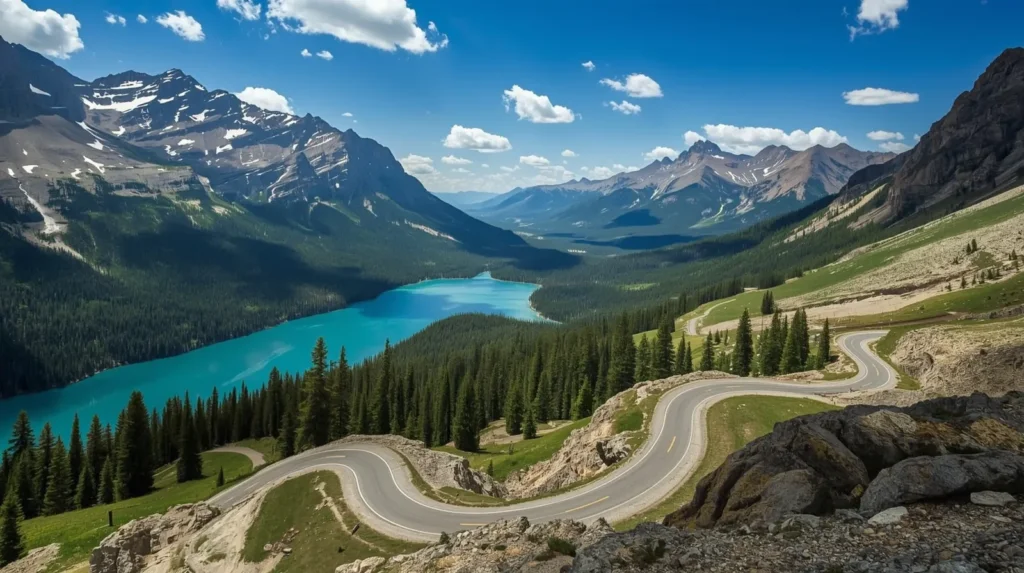
Image Credit: Leonardo
What Makes It Unique
Going-to-the-Sun Road is like stepping into a high-definition nature documentary. Located in the heart of Glacier National Park, this 50-mile route carves through some of the most awe-inspiring terrain in the U.S. Unlike the longer scenic highways, this one is short but dense with jaw-dropping beauty. Think towering peaks, glacial valleys, alpine meadows, cascading waterfalls, and more wildlife than you’ll know what to do with.
Built in the 1930s and designated a National Historic Civil Engineering Landmark, this road was a marvel of its time—and it still is. It crosses the Continental Divide at Logan Pass, giving you panoramic views of rugged mountain ranges and deep, glacial-carved valleys. Each switchback offers a new vista, more surreal than the last. It’s the kind of drive where you’ll pull over every five minutes just to soak it all in.
Points of Interest in Glacier National Park
- Logan Pass: The highest point on the road at 6,646 feet. From here, you can hike the Hidden Lake Trail or catch glimpses of mountain goats and bighorn sheep.
- Weeping Wall: A dramatic roadside cliff that literally weeps water down onto the road.
- Lake McDonald: The park’s largest lake, surrounded by mountains and famous for its colorful rocks and mirrored reflections.
- Wild Goose Island: One of the most photographed spots in the park—seriously, it looks like it was made for a fantasy film.
- Sunrift Gorge: A quick stop with rewarding views and short hiking trails.
Each of these points offers either short trails or scenic viewpoints, so even if you’re not a hiker, you’ll get plenty of natural eye-candy.
When to Go and Road Conditions
The road typically opens fully from late June to mid-October, depending on snow conditions. It’s not plowed in the winter, and snow can linger well into early summer. The best time to go? July and August, when all sections are accessible and wildflowers are in bloom. But come early or late in the season for fewer crowds.
Be prepared for narrow lanes, sharp turns, and sheer drop-offs. If you’re afraid of heights, consider taking a guided Red Bus Tour so you can enjoy the views stress-free.
5. Overseas Highway (Florida Keys)
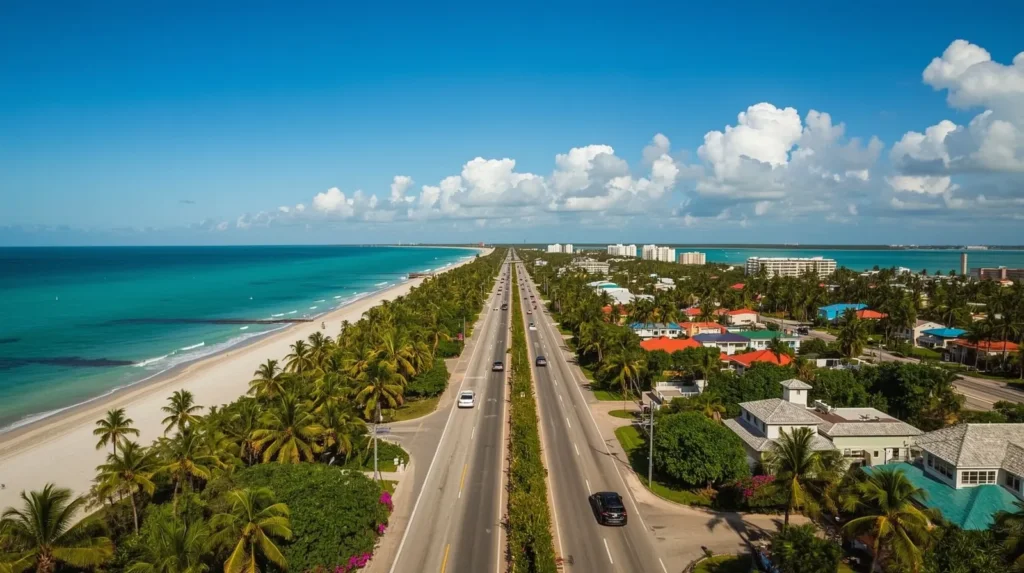
Image Credit: Leonardo
Stunning Ocean Views and Island Vibes
If you’ve ever dreamed of driving across the ocean (yes, literally), the Overseas Highway is your dream come true. This 113-mile route links the Florida mainland to Key West via a chain of coral and limestone islands known as the Florida Keys. With turquoise waters stretching on both sides and 42 bridges (including the iconic Seven Mile Bridge), it’s unlike any road trip in the continental U.S.
What makes it so magical? The juxtaposition of sea and sky. You’re essentially suspended between two blues—with the Atlantic on one side and the Gulf of Mexico on the other. At times, it feels like you’re sailing on a sea of asphalt.
And the vibe? Totally laid-back. Think flip-flops, Jimmy Buffett on the radio, and conch fritters for lunch. It’s a tropical road trip that doesn’t require a passport.
Key Stops You Can’t Miss
- Key Largo: Great for diving and snorkeling in John Pennekamp Coral Reef State Park.
- Islamorada: Known for sport fishing and relaxing tiki bars.
- Marathon: Offers family-friendly attractions like the Turtle Hospital and Dolphin Research Center.
- Seven Mile Bridge: The most photogenic stretch of highway—seriously, you’ll want to stop here for drone shots.
- Bahia Honda State Park: A hidden gem with stunning beaches and crystal-clear waters.
- Key West: The ultimate party town with Hemingway’s home, Duval Street, and epic sunsets at Mallory Square.
Each stop has its own charm and flavor, so don’t rush through—linger, explore, and enjoy.
Best Season to Hit the Road
The best time to drive the Overseas Highway is winter through early spring (December to April). The weather is warm, skies are clear, and hurricane season is over. Summer can be sweltering and more prone to storms, while fall brings hurricane risks. Always check the weather before you go.
Travel tip: Go during a weekday to avoid heavy weekend traffic and give yourself at least 2-3 days to experience the keys without feeling rushed.
Planning Your Scenic Road Trip Adventure
Choosing the Right Route
Choosing the perfect scenic route depends on your interests, time, and travel style. Are you a beach lover? Then the Pacific Coast Highway or Overseas Highway might be your calling. More into mountains and peaceful drives? The Blue Ridge Parkway or Going-to-the-Sun Road will be your jam.
Think about:
- How much time you have (some trips are better suited for a long weekend, others need two weeks).
- Your starting point (routes like Route 66 stretch across the country and require planning).
- Seasonality (some routes close in winter or are best in spring/fall).
- Your travel companions (are you solo, with family, or a group of friends?).
Researching the route in advance and planning daily mileage, lodging, and must-see stops can make or break your road trip experience.
Budgeting for the Journey
Road trips can be cost-effective, but costs add up quickly without a plan. Here’s a rough breakdown:
| Expense | Estimated Cost (per day) |
|---|---|
| Gas | $30 – $60 |
| Lodging (motel/hotel) | $70 – $150 |
| Food & drinks | $30 – $60 |
| Attractions/tours | $10 – $50 |
| Misc. (souvenirs, etc.) | $10 – $30 |
Tips:
- Use gas apps to find the cheapest fuel nearby.
- Consider camping or RVing to save on accommodation.
- Look for free attractions and state parks along the way.
Packing Essentials
Don’t hit the road without these:
- Maps or offline GPS apps (especially in remote areas).
- Snacks & water (healthy and hydrating options).
- First aid kit and medications.
- Car charger and power bank.
- Comfort items: travel pillow, sunglasses, blanket.
- Entertainment: playlists, audiobooks, podcasts.
Pack light but smart—overpacking means cluttered space, and nobody wants that on a road trip.
Safety Tips for Long Road Trips
Car Maintenance and Checks
Before embarking on a scenic drive, your first priority should be ensuring your vehicle is road-trip ready. A minor car issue can quickly derail your plans—and ruin what should’ve been the trip of a lifetime.
Pre-trip car maintenance checklist:
- Oil change: If you’re close to your service date, do it before hitting the road.
- Tires: Check for wear and tear, proper inflation, and rotate if needed.
- Brakes: Listen for squeaking or grinding—if you hear it, get them checked immediately.
- Battery: Make sure it’s fully charged and corrosion-free.
- Fluids: Top off coolant, windshield wiper fluid, brake fluid, and power steering fluid.
- Lights and indicators: Test headlights, brake lights, and turn signals.
- Wipers: Replace worn-out blades; visibility is crucial.
It’s smart to visit a trusted mechanic for a full check-up a week before your trip. Also, have your spare tire, jack, and jumper cables on board—just in case.
Staying Alert and Rested
Drowsy driving can be just as dangerous as driving under the influence. Road trips are fun but also exhausting—especially long hauls. Here’s how to stay safe and focused:
- Get a good night’s sleep before the first leg of your trip.
- Take breaks every 2-3 hours, even if it’s just to stretch and breathe fresh air.
- Rotate drivers if you’re not traveling solo.
- Stay hydrated and eat light snacks to maintain energy levels.
- Use cruise control on long highway stretches to reduce fatigue.
- Avoid driving late at night—vision is reduced, and your body naturally winds down.
If you feel even a bit tired, don’t push through it. Pull over, nap, or stop for the night. Your safety—and that of others on the road—isn’t worth the risk.
Emergency Preparation
You never plan for an emergency, but you must prepare for one. From breakdowns in remote areas to extreme weather, the unexpected can happen anywhere.
Build a car emergency kit that includes:
- First aid supplies
- Jumper cables
- Portable air compressor
- Tire sealant or patch kit
- Flashlight with extra batteries
- Reflective triangles or flares
- Blanket and extra warm clothes
- Bottled water and non-perishable snacks
- Multi-tool or Swiss Army knife
- Phone charger with power bank
Also, consider downloading AAA’s mobile app or enrolling in a roadside assistance service. Know the local emergency numbers of each region you’re passing through, and always let someone know your expected route and timeline.
How to Capture the Best Travel Photos
Photography Gear Recommendations
Your phone might take great pictures, but if you’re serious about capturing stunning visuals of your road trip, upgrading your gear can make a big difference.
Recommended photography gear:
- DSLR or mirrorless camera: Offers better low-light performance and higher detail.
- Wide-angle lens: Perfect for capturing vast landscapes.
- Tripod: Essential for stable shots, long exposures, and time-lapses.
- Drone: For breathtaking aerial views (check local drone regulations).
- Lens cleaning kit: Dust and dirt are inevitable on long trips.
- Extra memory cards and batteries: Always have backups—you’ll thank yourself later.
Don’t underestimate your smartphone, though. Many modern phones rival mid-range cameras, especially with built-in HDR and editing features.
Tips for Scenic Shots
- Golden hour is your friend: Shoot at sunrise or sunset for magical lighting.
- Rule of thirds: Position your subject off-center to create balance and intrigue.
- Use leading lines: Roads, railings, or fences can guide the viewer’s eye through the image.
- Capture motion: Show the movement of your car, waves, or clouds for dynamic photos.
- Get in the frame: Use a tripod and timer or ask someone to snap you enjoying the moment.
- Don’t skip the details: A close-up of your hands on the steering wheel or the dashboard map tells a story.
Editing apps like Lightroom, VSCO, or Snapseed can give your photos that extra pop.
Sharing Your Journey Online
Once you’ve taken your epic shots, why not share the adventure?
- Create an Instagram carousel: Mix landscapes with candid moments.
- Use geotags and hashtags: Helps others find your location and tips.
- Start a travel blog or YouTube channel if you’re into long-form storytelling.
- Consider Reels or TikToks: Short-form videos with music get great engagement.
Don’t feel pressured to post everything in real-time. Sometimes, the best moments happen when you’re disconnected and present. Capture now, share later.
Making the Most of Your Travel Time
Playlist and Podcasts
A scenic road trip isn’t complete without the perfect soundtrack. Music and stories help define the vibe of your adventure and can even become part of your memory of the trip.
Playlist tips:
- Mix genres: classic rock, indie, country, and feel-good pop.
- Add road-themed songs like “Life is a Highway” or “On the Road Again”.
- Include relaxing instrumentals for scenic stretches.
- Use apps like Spotify or Apple Music to pre-download playlists for offline use.
Podcast recommendations:
- True crime: “Serial”, “Crime Junkie”
- Travel stories: “Zero To Travel”, “The Moth”
- History buffs: “Hardcore History”, “Revolutions”
- Comedy: “SmartLess”, “No Such Thing As A Fish”
Rotate between music and podcasts to stay mentally fresh.
Local Eats and Snacks
Fast food is convenient, but local bites are part of the charm. Wherever you stop, look for:
- Diners or mom-and-pop restaurants for regional flavors.
- Food trucks in city centers or roadside pull-offs.
- Farmer’s markets for fresh fruits, baked goods, and crafts.
Also, keep a snack bag handy with:
- Trail mix
- Jerky
- Granola bars
- Fruit
- Electrolyte drinks
- Gum or mints
Being well-fed keeps morale high and helps you avoid “hangry” arguments in the car.
Travel Journaling and Memories
Don’t let your epic adventure fade into a blur. Document your trip daily—even just 5 minutes a day. Your future self will thank you.
Ways to preserve your journey:
- Keep a physical journal or notebook.
- Use voice memos to capture thoughts on the go.
- Take short video clips at each major stop.
- Collect postcards or souvenirs from each town.
- Start a blog or digital photo album.
It’s not just about where you went, but how you felt while you were there.
Environmental Tips for Responsible Road Trips
Leave No Trace Principles
Traveling should be about making memories—not messes. Adopting Leave No Trace principles ensures that future travelers can enjoy the same pristine landscapes you did.
Here’s how to tread lightly:
- Pack it in, pack it out: Take all trash with you, including food wrappers and disposable bottles.
- Stay on designated trails and roads: Off-roading can destroy delicate ecosystems.
- Don’t feed wildlife: It can disrupt their natural diet and behaviors.
- Respect nature: Don’t pick plants, carve trees, or remove natural objects.
- Minimize campfire impact: Use fire rings, keep fires small, and never leave them unattended.
When you leave a place, it should look like you were never there. That’s the essence of responsible travel.
Eco-Friendly Travel Hacks
Being eco-conscious on the road doesn’t require massive sacrifices. A few simple swaps and habits can significantly reduce your carbon footprint.
- Reusable containers: Bring a refillable water bottle, coffee mug, and food containers.
- Cloth napkins and utensils: Avoid single-use plasticware by packing your own.
- Solar chargers: Power your devices using sunlight—especially handy for camping.
- Hybrid or electric cars: If you’re renting, choose a greener vehicle.
- Eco-lodging: Look for hotels or campsites that emphasize sustainability.
Apps like iOverlander and Green Travel Maps can help you locate eco-friendly stops along your route.
Supporting Local Communities
Travel isn’t just about the places—it’s about the people. Supporting local communities adds meaning to your journey and boosts the economy of the areas you explore.
- Buy local: Shop at markets, eat at family-run restaurants, and purchase handmade souvenirs.
- Stay small: Choose boutique hotels or locally owned Airbnbs over large chains.
- Learn and listen: Engage with locals, learn about their culture, and travel with humility.
- Volunteer: Consider donating time or money to local causes, especially in smaller or rural towns.
When you travel responsibly, you leave a positive mark—not just on the environment, but also on the lives of others.
Conclusion
A scenic road trip across the U.S. isn’t just about getting from point A to B—it’s a soulful journey through the heart of America. From the rugged cliffs of Big Sur to the endless blues of the Overseas Highway, each road tells its own story and reveals a different slice of this vast and diverse country.
Whether you’re chasing fall foliage on the Blue Ridge Parkway, retracing history along Route 66, or marveling at glaciers on Going-to-the-Sun Road, the experiences are as varied as they are unforgettable. But beyond the landscapes and photo ops, road trips offer something deeper: freedom, spontaneity, connection, and self-discovery.
So, pack your bags, start your engine, and hit the road. The adventure of a lifetime is just a highway away.
FAQs
What is the best time of year for road trips in the US?
The best time depends on your route. Spring (April–June) and fall (September–November) offer mild weather and fewer crowds for most areas. Summer is great for mountain drives like Going-to-the-Sun Road, while winter is ideal for southern routes like the Overseas Highway.
How do I plan a cross-country road trip?
Start by choosing a route (like Route 66), then map out your stops, daily mileage, accommodations, and must-see attractions. Use apps like Roadtrippers or Google Maps, and build in time for spontaneous detours and breaks.
Are scenic road trips safe for solo travelers?
Yes, but with precautions. Share your route with a friend or family member, check in regularly, stay in well-reviewed lodgings, and avoid isolated stops at night. Trust your instincts and always have a backup plan.
Can I rent a car for a long road trip?
Absolutely. Many rental companies offer unlimited mileage for road trips. Just make sure to check for restrictions on interstate travel, return policies, and ensure the car is in excellent condition before setting off.
How do I find the best scenic detours along the way?
Use travel blogs, Instagram geotags, or apps like Roadtrippers, AllTrails, and Google Earth. Often, local visitors centers and gas station clerks know hidden gems too—don’t be afraid to ask!

